Chickens Day - Raising Day Old Chicks
When I was growing up, we had a bantam flock. It free ranged all over the neighborhood because in the 1960’s the only predators were the neighborhood dogs. The hens would go broody and hatch chicks wherever they wanted to. We had little input in that.
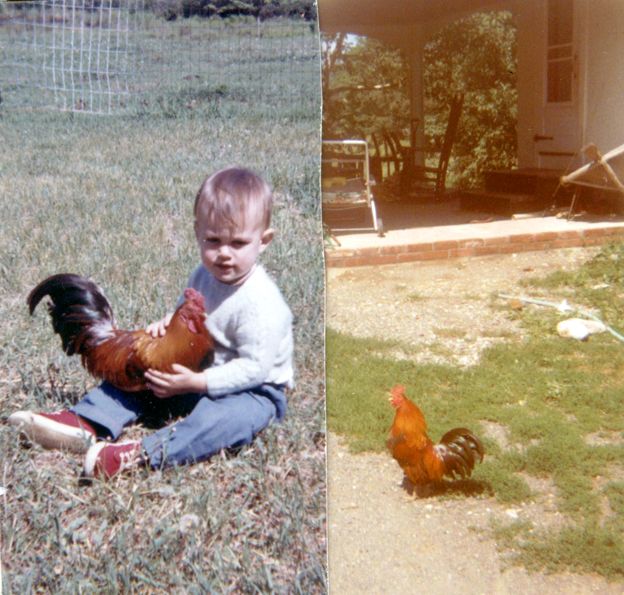
When we started raising chickens in 2008, it was a whole new world. We have a very high predator load here. In fact, it’s easier to say what we don’t have: wolves, wolverines, and lynx. So starting with day old chicks meant we had to be very proactive about protection from predators.
We planned to raise enough birds to have 1 a week during the year. There were going to be NO layers, I had been strictly informed. (That’s another story coming later…) We had read Joel Salatin’s Pastured Poultry Profit$, done research on brooders and pasture tractors, and read up on chick care. But like most things, you don’t REALLY know how to do it until you do it.
Once you’ve decided what breeds of chicks you want, you need to order them. There are 2 choices: from a feed store or through the mail, unless you are lucky and live near a breeder. If ordering through the mail, they only ship as few as will maintain a warm temperature in the box, usually 25. But they ship direct to you and you will put them immediately into their environment.
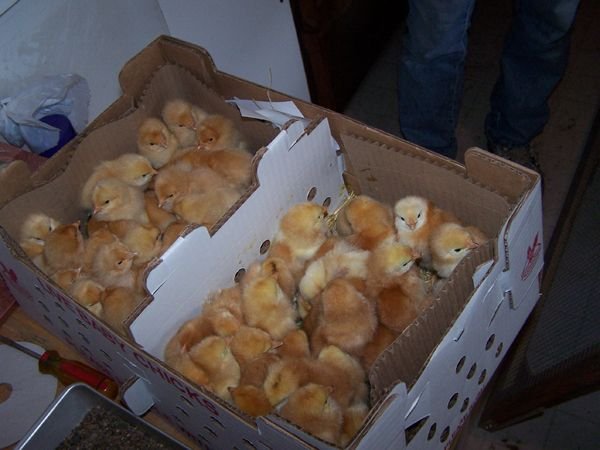
If you get them from the feed store you can get as few as you want, but be aware they have been subjected to additional stress. This is from being in an open area with lots of children and adults around. You don't know what diseases may have been brought into the store. Also they learn to eat in one place, then you transport them to a new one and they must learn again, never mind the stress of transport.
They will need warmth, plenty of space, food and clean water, ventilation and no drafts, protection from the wet, and from predators.
Temperature and Warmth
The most important thing chicks need is plenty of warmth. The first week after hatching the minimum temperature should be 95F. You can drop this by 5 degrees every week after that until they're 6 weeks old. Then, if they are fairly feathered out and unless you live in a very cold area, they are able to withstand normal temperatures. Note that only part of the brooder needs to be this temperature, as the chicks need to be able to cool off when their bodies need to.
If they get too cold they will pile up on each other and the inside ones will smother. If they get too cold, the stress can cause diarrhea or pasty butt.
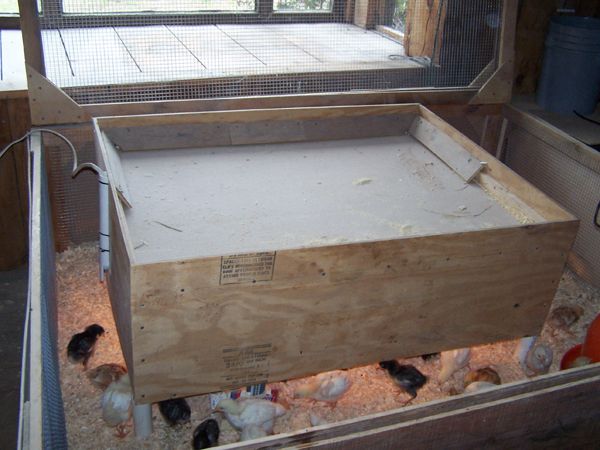
Size of Living Area
Until your chicks are four weeks old, they will need half a square foot per bird. So if you have 5 birds, you need an area 21” on a side. If you have 25 birds, you will need 3.5’ on a side. If your area is too small picking may start. Red light helps prevent picking but the best preventative is plenty of room.
The area needs to prevent drafts, but allow good oxygen exchange. There has to be enough ventilation for fresh air but no drafts. These birds need a lot of oxygen. Any corners need to be rounded, to prevent piling up if they get cold.
Bedding
In the beginning, the floor should have nothing but flat paper with feed spread on it, so they will learn what is food, before they are shown bedding. After a couple days, when all chicks are eating well and have found the feeders, the paper can be covered or replaced with bedding.
Some will say that paper will cause spraddle leg but we’ve never seen it in 10 flocks of birds of up to 80 birds.
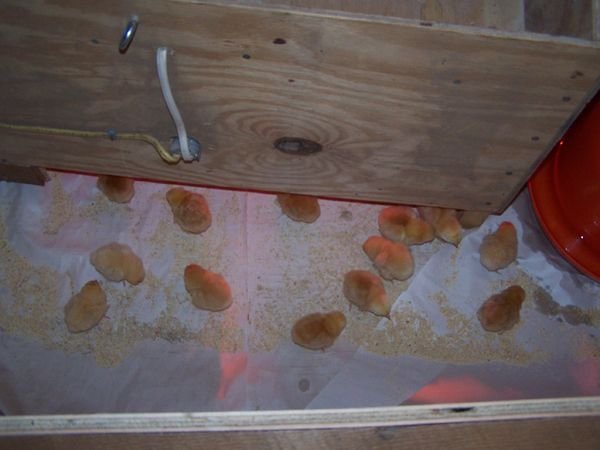
Wood shavings, rice hulls, or ground cobs make good litter. Do not use cedar chips, sand and sawdust (too small and the birds may eat it instead of their food), or treated wood chips. Straw or dirt will also work but are not as good as the others. Put the litter all over the floor at least 1 inch thick.
It does not need cleaned daily, but fresh litter should be put down, either over the old (deep litter) or replacing the old when it’s sufficiently dirty. Never any wet spots. If it gets wet, it should be replaced immediately.
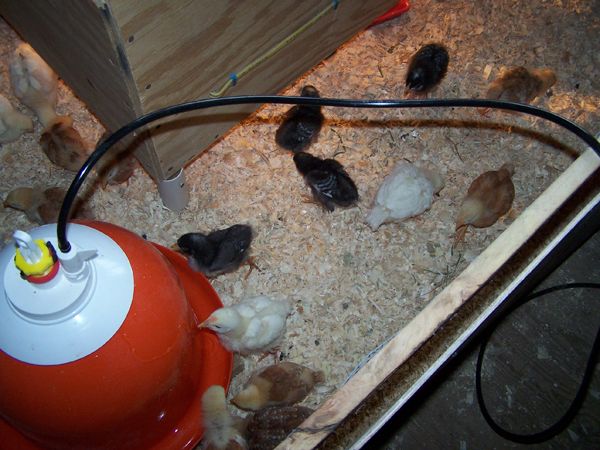
Predators
If the chicks are raised in the house, household animals may be the main predator problem. But if they are in a brooder outside, rats, weasels, and larger predators like raccoons or opossums can become a huge problem quickly.
The best way to prevent problems is to be prepared for them. Know the density of any predators in your area (within a square mile or more). If there are rats next door, be prepared and use materials that can’t be chewed through. Be aware rats can squeeze through an amazingly small hole, but ½” hardware cloth will stop them. But mice will get through. It is doubtful mice will be after chicks, just the food. And in a few weeks, the chicks will be after the mice.
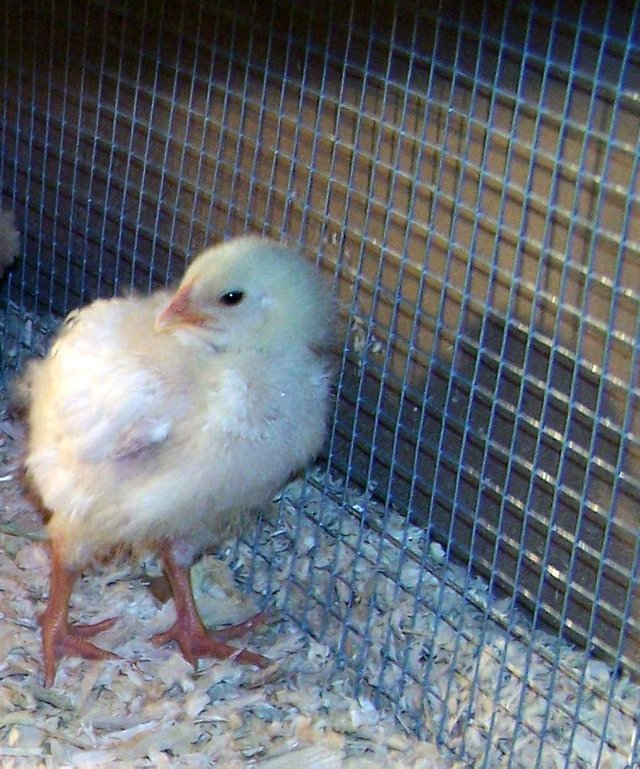
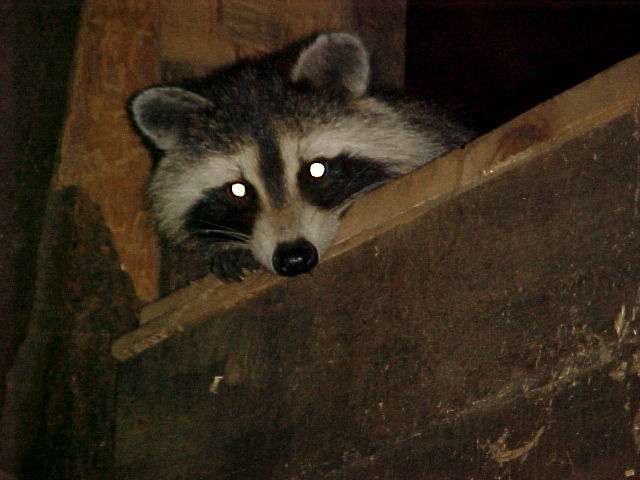
↑ Momma coon looks down from our loft
If raccoons are around, it’s best to go with ½” hardware cloth, as they can reach right through chicken wire. Make sure any wire is very firmly stapled with 1” fencing staples. Use the cloth on all sides, top and bottom, as predators are very persistent.
Make sure latches on doors aren’t easily flipped open. Use latches that require a good amount of thumb dexterity to open. Don’t rely on heavy weights to keep top doors shut. Raccoons can move amazing amounts.
Feed and Water
Make sure you have enough feeder and waterer space and that they never run out. You need enough feeder space for most of them to eat at once. Use a 2 foot feeder for each 25 chicks. Have a 1 gallon chick waterer for each 50 birds.
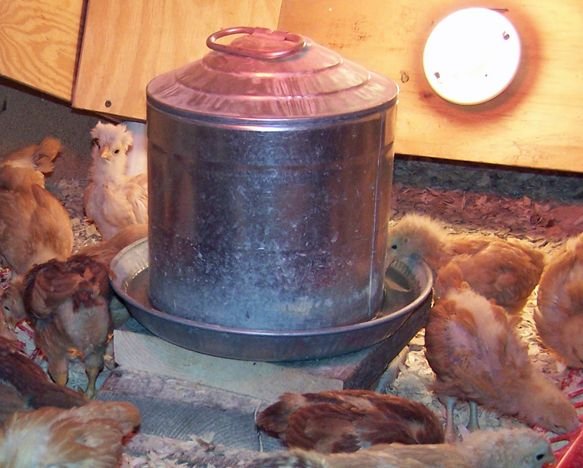
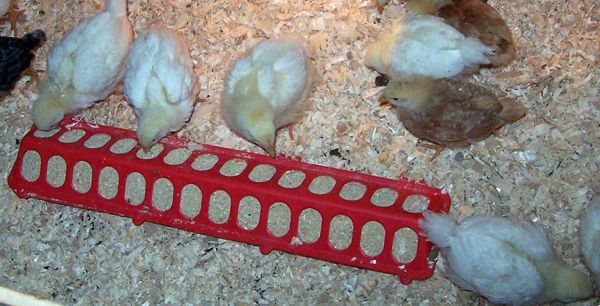
Make sure the ration is right, especially protein and mineral levels. And are
they eating enough? The first week they will eat 1.6 oz. of feed/week/per bird. The second week they will eat 3.2 oz of feed/week/per bird.
Feed a good commercial starter feed to start off, then at about 2 weeks, start supplementing with tiny amounts of animal protein, about 1/16 oz per bird/day. You can also add tiny amounts of vegetables, fruits, or scratch.
Be very careful that they continue to eat all the commercial feed, in addition to the supplementation. In general, the birds of today are bred to do well on commercial feeds.
The feeder height should be set so the lip of the feeder is level with the chicks’ backs. As they grow so fast, the feeder must be raised regularly. The waterer must also be set at this level, but for a different reason. If it is too low, the crop will empty into it when they drink, fouling the water.
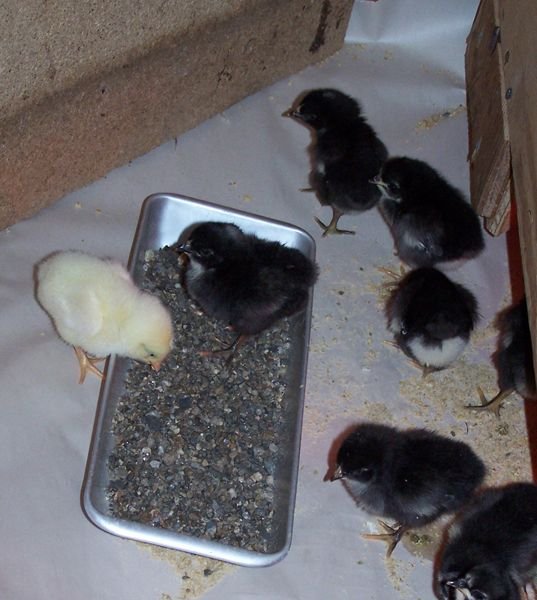
If you supplemental feed, provide granite grit, in chick size. They will need it to digest the food.
Disease and Illness
You can chose to have your chicks vaccinated for diseases but be aware that if you do, all future batches must also be vaccinated. This is because the vaccinated chicks will be shedding a form of the disease vaccinated for, into the living areas.
Insufficient nutrients, calcium and protein can cause various problems. Not enough calcium can cause leg problems. Not enough protein means small birds that will not produce as well.
Too much stress, from too hot, too cold, too much handling, drafts, being in a damp area, or being picked or piled on can bring on illness. Pasty butt, where the feces block the vent, is a common ailment in this case. Don't overlook the potential for coccidiosis or stress to make birds uncomfortable.
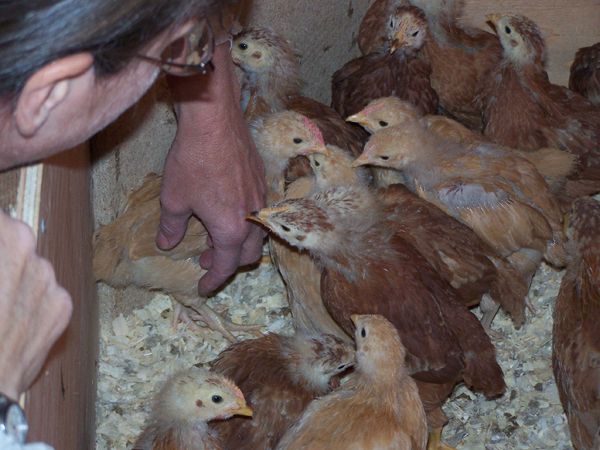
Make sure the birds are comfortable. No overcrowding. A good balance of warm and cool. NO ammonia levels and lots of fresh bedding in the brooder. Plenty of food and clean water.
McMurrary’s Chick Care Site:
http://www.mcmurrayhatchery.com/chickcare.html
Feeding Amounts: http://www.afn.org/~poultry/flkman9.htm

Community Forums
Wonderful post. I love the pictures of new baby chicks. Fabulous information.
It is amazing how in different areas people do things a bit different. We live in Northern Alberta Canada and due to the cold we need more bedding for our chicks. On day one the bedding needs to be at least 6 inches deep for them to help keep the warmth in.
I think it is fantastic that you don't need as much bedding.
Thank you for sharing!
The reason we don't need more bedding is that the brooder is in our cold room, a heavily insulated room for hanging the meat. It maintains the proper temperature with very little heat input. I am glad I don't need so much bedding for 2 reasons: 1. the brooder elevated legs would have to be much longer and used from the beginning, and 2. I don't have so much to clean out at the end of the brooder time. So I cheat. :))
Sorry so long to respond, bandwidth locked me out. :((
No worries about the long response. I am not on top of all of this myself this weekend, we have a house full of company.
It is wonderful that you are able to cheat that way. I think we need to cheat when possible. It makes life easier, and why shouldn't it be easier in some ways.
Thank you for contributing your knowledge to help others! This post has been added to the Sotall.org Directory of Self Sufficiency & Survival posts. One of our goals is to provide access to the knowledge of our fellow Steamians, that will still be seen, long after the 7 day period is passed. If you write any future articles with instructions on how to do any tasks related to a homestead or survival, to ensure they are added to the directory, please submit them. They will be added as soon as possible.